
|   |

|   |
 e-mail: leelakaverivenkat@gmail.com Getting to know Vitasta's gift to India Photos courtesy: Kalakshetra March 2, 2023 VITASTA, the ever flowing legacy of Kashmir, a four day event, sponsored by the Ministry of Culture, on the occasion of Azadi ka Amrit Mahotsav, held amidst the spacious environs of Chennai's Kalakshetra, proved to be a once- in-a-lifetime experience. It provided intimate, vital, and ineradicable glimpses, of that part of our country, symbolising its very spirit and consciousness. A well-knit effort, involving a host of names like Siddharth Kak as resource person, Bharat Gupt, Trustee and Executive Member IGNCA, Director of Kalakshetra Revathi Ramachandran, who played an active role in laying out the basic format, Dr.Chandrakant Gariyali with her vast experience in the Centre and Tamilnadu (committed enough to come all the way from Australia where she was visiting her son, to participate in the event), the Sahitya Kala Parishad which organised seminar talks on the first day (followed by two days of lectures arranged by Revathi), the North Zone Cultural Centre which provided cultural groups from Kashmir to stage performances, the Lalit Kala Akademi which sent craftsmen to participate and organise stalls, Seerat Narendra who provided the décor for the festival, et al, in different roles - all participating in what was by any standard, an extremely well-crafted endeavour. 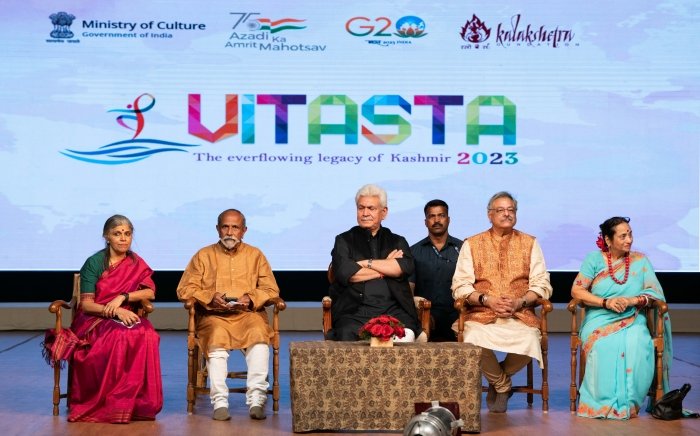 Inauguration In the news as Kashmir is, for all the wrong reasons, how many of us realise, as many speakers pointed out, that the beginnings of India's historical, literary, philosophical, religious (Shaivism, Buddhism, Vaishnavism, Shakta worship), cultural, architectural history, are all to be traced from Kashmir? A riverine civilization, Kashmir is the gift of river Vitasta, now known as the Jhelum. As vital as the Ganges is to the plains of North India, is Vitasta around which a life style evolved, of the Kashmiri. Worshipped as a manifestation of Parvati, who on Shiva's urges, in response to the penance of Kashyap Muni to alleviate man's cry for water, created this river. Mentioned in Rig Veda as one of the twenty one most important rivers, the Neelamat Purana described the land round the river as Vetastika. The Mahabharat mentions praying and bathing in its waters as being the hallmark of all salvation. Lord Krishna is believed to have come to Kashmir to attend the Swayamvar of Gandhari. The seat of all learning in India, Kashmir has a history going back to about 4000 years at least. It is here that the legendary Abhinavagupta, c 975- 1016 CE (who hailed from UP and settled in Kashmir according to some, while many believe he was born in Kashmir) wrote his forty odd works in Sanskrit, his Abhinavabharati the commentary on Bharata's Natya Sastra, paving the route and means to understanding this great text. His major oeuvre Tantraloka comprising 5800 verses (after he had attained enlightenment), is the most authoritative work on nondual Shaivism of Kashmir. Another great work of his is Locana, the third eye, a critique on Anandavardana's (c 820-890 CE) - another great son of Kashmir and paramount aesthetician - Dhwanyaloka, on the dhwani or vyanjana theory of aesthetics, where importance is placed on aesthetic suggestion. Abhinavagupta prescribed a ninth Shanti rasa above the known ashta rasas. Kalhana's Rajatarangini, the first ever written record of history, was again from Kashmir. Kashmir was also the home of 11th century poet Bilhana whose Chaurapancakshika (fifty verses of the thief) is a very passionate work on forbidden love for a princess. Excavations, as in Burzahom, give proof of surgical feats performed here. The surfeit of epigraphical material found here, is still to be deciphered. Terracotta sculpture found in Buddhist sites in Kashmir show Grecian features speaking of early interactions with that part of the world. Somadeva Bhatta of Kashmir is the one who compiled the Katha Saritasagar, tales evolving round an uninhibited celebration of life, written for the Queen of Kashmir in 1070 A.D, and out of such stories must have come the future Arabian Nights and Panchatantra stories. As early as in 719, the great King Lalitaditya who ruled over Kashmir for over forty years, over territory bigger than Ashoka's, and who kept the Central Asians at bay not allowing them to enter Indian soil, does not even find mention in our history books! There is reference about dance taking place in the temple built by him. Less verifiable is the birth of Kalidas said to have belonged to Kashmir and it is said that he left because of the tyrannical rule of the King at the time. Sanskrit theatre in India had its strong presence in Kashmir. Kashmir was the seat of the renowned Sharada civilization (the actual place now in occupied Kashmir) and it was during this time that the great temple University Sharada Peeth (6th to 12th centuries) attracted scholars from China, Laos, and several other places. Indian scholars like Kalhana, Kumarajiva and Adi Shankara were said to be among its 500 scholars. It was here that the famous Sharada script with which any language can be translated, evolved. Innumerable manuscripts in this script are on Ayurveda, Astronomy, Yoga. This area, now in occupied Kashmir, near the confluence of Kishen Ganga and Madhumati waters in Sharada village, had the temple of Sharada at the place venerated as the shakti sthal where Sati's right arm fell, when a prostrate Shiva, agonising over her death roamed carrying her burnt body. Goddess Sharada, whom scripture describes as Kashmeera puravasini is the Kuladevi for Kashmiri Pandits. Several scholars like Prof Beena Budki and Dr. C.K. Gariyali provided insights into the Kashmiri way of life. Prof Budki said that with the Kashmiri dress with Poots, Pheran and Taranga headdress, the veil has no place. Footwear made of grass is worn by devotees entering spaces where poojas are being performed. It was interesting to hear how Shivaratri is celebrated over three days and in February when places are ice clad! Walnut (acroot, the dry fruit) regarded as a symbol of the four Vedas is used a lot for poojas and during Dwadashi for decorating homes too. Marriage customs and beliefs of the Kashmiri people were touched upon as also the festival of Navroz when one finally bids farewell to snow. There was mention of Kashmiri bread of various types sold in special places, meant for different occasions like tea, breakfast etc. as a very significant part of Kashmiri food. Tea is of two types - one sweet with dry fruit in it and Namkeen Chai with salt, which is particularly favoured by Muslim households. Festivals, common to many Indians like Ganapati puja, Janmashtami are celebrated, but with a very original Kashmiri slant. While the proverbial 'sweets' as good wishes, can be seen as in most of India, it is interesting to hear, how even for a bride entering her in-law's home, a wee bit of salt has to be part of the gifts. Giridhar Mamidi took listeners on a real yatra of Jammu/Kashmir temples, citing the special features of each. Barring a few temples, like Amarnath at Pahalgam, Avantiswamy temple at Anantnag, the Martand temple in Srinagar, Ksheer Bhavani temple and Vaishno Devi in Jammu, which tourists make a point of visiting, Kashmir, as one of the valleys (Nags - springs - believed to be from the locks of Shiva) is dotted with a plethora of temples not known. Giridhar Mamidi's talk took one on a tour of countless shrines -- largely destroyed, part destroyed, some with the main idol changed, and a few totally intact. While the entire list of temples mentioned would be difficult to recollect fully, fascinating details about some temples dotted the lecture - like the Beerwah cave associated with Acharya Abhinavagupta which now is considered a den for leopards and snakes, the Bumzu cave in Anantnag district and the fact that Kashmir has three Kheerbhavani temples. Mention was made of Katyayini temple which now has a saligramam from somewhere which has survived. Kapaalmochan temple at Shopian with snow falling on its unique Shivaling is now looked after by the Razdan family. Then there is the Tullamulla Keerbavani temple where the waters in the spring change colour - believed to predict ominous calamities when waters turn black or red. Among so many destroyed temples is the Balatripurasundari temple now being revived. The partly excavated Manasbal temple with a Ganesh has waters, which, at any temperature, do not freeze! At Shadipura where the Vitasta and Sind waters meet, is a temple dating back to Neelmatpuran times! Baramulla (described as 12 mullahs actually stands for Varaha mulla) where there is an ekamukha Shivaling. In Uri town is a Pandav Mandir being built right on the line of control, by a Sadhu from Odisha! A new Sharada temple is being, or is to be erected at Teetwal in Bandipura. At Wadipura Badarpur, the Rashtriya Rifles are guarding a temple with a massive tree which comes out with red fluid, when cut! In Srinagar cantonment, heavily guarded, is the Pandrethan Pandav temple, where on granite slabs, the name of every martyred soldier in Kashmir, is etched - and there are three to four blank granite slabs with no names - suggesting that the struggle to guard what belongs to the country, will not cease. On the other side of the border is the Sharada temple, out of bounds for people from India. Prof. Rathan Lal Hangloo made references to Kashmir's close ties with Tamilnadu mentioned in Pingala Upanishad (exact date of the syncretic view of Samkhya and Vedanta not certain but believed to be early medieval era. The text is mentioned by Shankaracharya too). Dr. J Jegannathan in his talk 'Adi Shankara from Kalady to Kashmir' referred to exchanges between extreme north and south of India, and of Kashmiri Pandits donating to the Tiruvidaimarudoor Shiva temple, as mentioned in an inscription. Bilhana, the historian, is said to have settled in Karnataka region. That Adi Shankara restored Sanatana dharma after years of Buddhism, is not doubted. The Sharada script, if fully deciphered, can yield hitherto uncovered material on the connections which took place. The Burzahom archaeological excavations in Kashmir (referred to earlier) indicates contacts with people in the Gangetic plains and peninsular India. A skull with trepanation surgery marks almost 3000 years ago, has led to conclusions about surgeons from Tamilnadu and Kashmir teaming up for challenging medical work. A very apt remark came from a speaker about the first 'Bharat Jodo' Yatra being undertaken by Shankara. According to Alexander Cunningham, the Shankaracharya temple dedicated to Shiva in Kashmir (some connect Ashoka's son Jaula with this temple) on Zabarwan hill was in the 8th century visited by Shankaracharya and he is said to have composed Saundarya Lahari here - but these statements have not been fully verified. Names like Meenakshi and Vaishnavi being common in Kashmir suggest a close contact with South India. Within 150 years of Buddha's Nirvana, Buddhism is believed to have come to Kashmir. Dr. C.K. Gariyali and Advaitvadani Kaul spoke on this subject, which both the Neelamat Purana and Kalhana's Rajatarangini mention. Buddhism is believed to have come during the time of Surendra, Ashoka's predecessor, and from here, it spread to Ladakh, Tibet and China. A Buddhist monk from Varanasi, Majhantika is believed to have introduced saffron cultivation for which Kashmir is known. Ashoka invited several Buddhist monks to the Buddhist council in Pataliputra and arranged to send missionaries to different parts of Asia to spread Buddhism. Kalhana mentions the stupas built by Ashoka. Kushan Kanishka was also a great builder of Buddhist viharas. From 630-760, Buddhism enjoyed a prominent place. And mention is made of how the religion lived alongside Shaivism leading to the concept of Tara, an icon venerated by both Hinduism and Buddhism. Hiuen Tsang mentions Buddhism being persecuted by Huns. The speaker mentioned monks like Ashvagosha (who first opposed Buddhism as a Hindu and then became a staunch convert), and Nagarjuna. Advaitvadani Kaul talked about the Mula Srivastavada school of Buddhism, Kashmir is famous for. Mathura and Kashmir were centres of meditation for Mahayana Buddhism. Kumarajiva, as one of the greatest translators of Buddhist texts from Sanskrit to Chinese, was largely responsible for the spread of Buddhism in China. Thanks to his translations, Tibet now has many of the Buddhist texts, lost in India. Speaking on Islamic culture, which through trade and missionary zeal of Sufism in the 14th century, made its presence felt in Kashmir, Prof Ghulam Rasool Jan, stressed the close affinity between India and Iran and how Persian language with the patronage of monarchy, coupled with Sufi mysticism, influenced the art and culture of Kashmir. Hindustani music was deeply influenced and the music of Qawals preached the language of love and harmony, finally leading to multi culturalism in Kashmir. K.Sreenivasa Rao also referred to multi-cultural Kashmir, with several languages like Persian, Sanskrit, Urdu, Dogri and the Kashmiri language. Bharat Gupt, as keynote speaker, with so many subjects having been covered, chose to confine himself to Acharya Abhinavagupta's philosophy, as the need of the hour today - the subject from a different approach having been discussed earlier by Rajneesh Misra speaking on 'Agamic assumptions of Abhinavagupta's poetics and aesthetics'. Bharat Gupt began by screening a visual image of a pen portrait (a painting by Sheshagiri Rao) of Abhinavagupta playing Nada Veena, drawing attention to the words of Madhuraj Yogin (who travelled all the way to become a student of Abhinavagupta) below, pithily describing the Acharya, as the very incarnation of Dakshinamurthy, seated in Veera Yogaasanasthaha - his tranquil expression the very avatara or manifestation of Kaantam. The word Vyas, the speaker continued, which means 'to expand' in Sanskrit, is a prime quality in Vyagyaakaars presenting a world view. What does a culture stand on, if its eternal values are not understood? Traditional poetics, Moral Relativism, and Abhinavagupta's extraordinary theory of reconciling conflicting strands of thought -- metaphysical, epistemological and philosophical under one overall uniting principle, are the pillars on which the Indian approach to life rests. Similarly, while rasa as the eternal point of creation with Vibhava, Anubhava and Vyabhichari Bhava had been discussed by Bharata, Abhinavagupta summed up the collective watching by an audience, as a single unified experience with the emergence of rasa belonging to a state-of-being which does not transpire or get evoked, when one watches a performing art by oneself. Diversity in our life-view, is accepted in full. But above this, a fundamental unifying force bringing all streams together is what Abhinavagupta stressed. Inclusiveness amidst diversity was the key to his theory. Like so many 'swaras' existing, each in its own right, coming together in a raga which is 'ranjaka' or enjoyable, inclusiveness of individual approaches in a fundamental overall unity is what our philosophies believed. As Rajneesh Misra had also summed up in his talk, Abhinavagupta's approach had neither prescriptions nor prejudices. Our Parampara believes in continuity and cumulativeness. Sadhana lay in discovering that reality, knowing which, everything else is known. Knowledge was that which ensured liberation. Otherwise it was Agyan. Voicing with fire and passionate conviction, the contrast between what Kashmir has contributed to history as against what it has been through, was eminent poet Agnishekhar during his valedictory address. Holding listeners spellbound, he spoke of the lost history, along with philosophical and cultural continuity which is the lot of Kashmiris. And all this despite their deep contribution to Vastu Sastra, Chitra Sutra, Natya Sastra, Alankara Sastra, Dhwani theory and much else. Dwelling on a lot of aspects, he pointed out to the first line of the Vedas, "Agnimile purohitam," a homage to Agni, as also to apo (water), and how the Kashmiri faith was in feeding and keeping the hawan flame burning and pure. Sastra, while fine, needs protection too. Not denying the contribution to Kashmir and its culture through the coming of Islam and Sufi philosophy, he also regretted the violence which had come later. Buddhism for several centuries in Kashmir preached compassion, and with handicrafts and musical and dance forms of the Muslim Sampradaya and the coming together of Islamic/Pandit culture in Kashmir, the archetype may have changed, while what was intrinsic did not. Dogged with the violence over the years, Kashmiris face a conflict of conviction and Pandits are left with a persecution complex. In a passing reference to his book collection which was burnt when his home was destroyed, he mentioned the presentation to his daughter as dowry, of forty odd volumes of Tantraloka! 'Bharata and her Kashmira' was an interesting talk by Megh Kalyanasundaram. Today, in intellectual discussions, cynical questioning on the very notion of Bharatavarsha as a politically cooked up concept, which is not part of our past, is common. The traditional pooja sankalpam establishing the provenance of the event has the Sanskrit words " jamboodveepe Bharata varshe bharatakhande meroho, dakshine parshve …" from the scriptures. With Sanskrit quotes from various texts set to catchy music sung in his own voice, Megh Kalyanasundaram recited that part of the Rig Veda, referring to the land bounded by Himalayas in the north and the sea in the south named bharatam nama has been mentioned. Quoting from the Neelmat Puran, from Kalhana's Rajatarangini, from the Natya Sastra, he supported his statement of the idea of Bharata varsha, the concept not newly coined by any means. In the Mahabharata, Sanjaya's description of Bharata varsha mentions mountains, rivers, and what clearly emerges is a geographical map of mainland India as it is today (minus islands). As an additional proof for those always looking for western validation, he mentioned the map of Bharata varsha in the Historical Atlas of South Asia by western geographer, Joseph Swartzberg, who was Fellow of the American Institute of Indian Studies. Geographically, if one draws a map according to the boundaries mentioned in these texts, it includes the whole of mainland India. Kashmir in Kathasaritasagara is mentioned as "Prithvi Shiromanihi" (jewel on earth). With four days of long sessions, one missed talks on Daughter of Vitasta, Lalleswari and her Vaks, on Kashmir Shaivism, on Islam and on Kalhana's Rajatarangini. 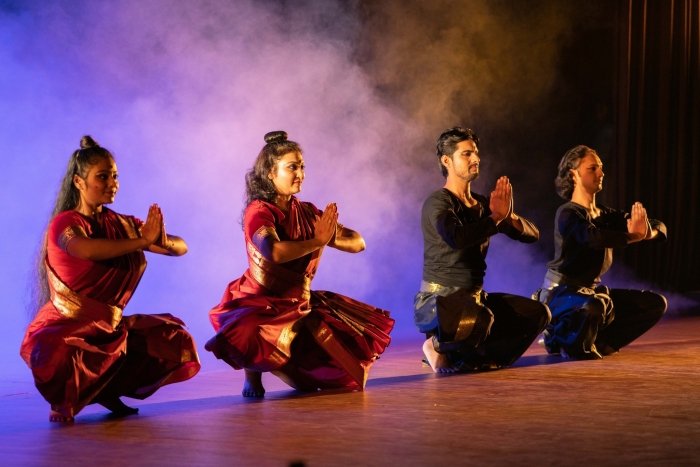 National School of Drama 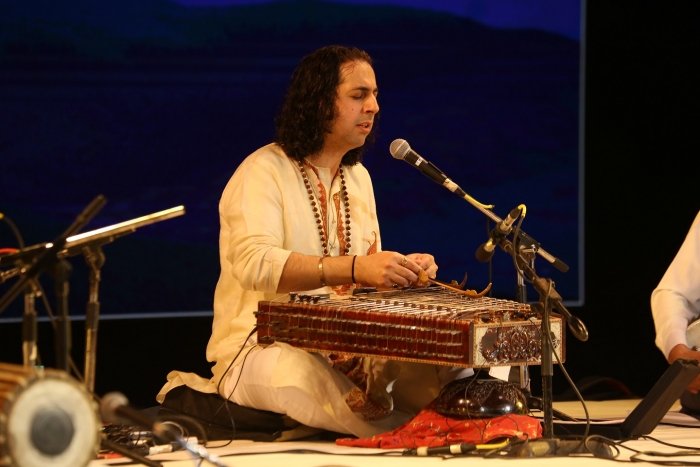 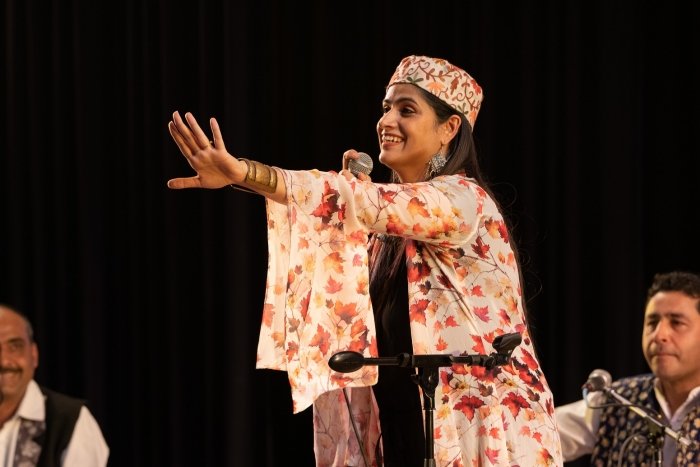 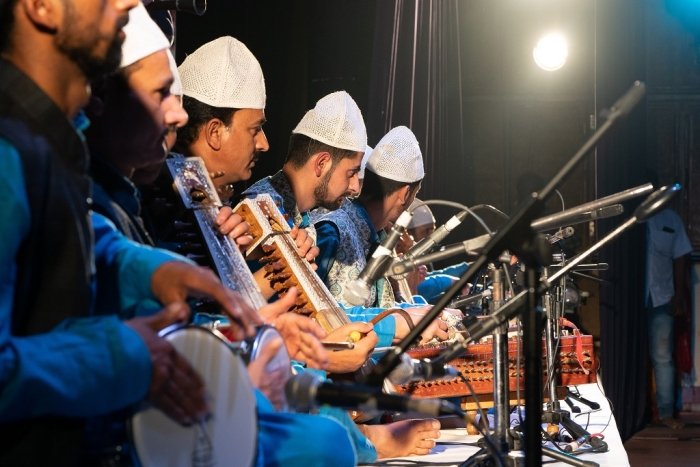 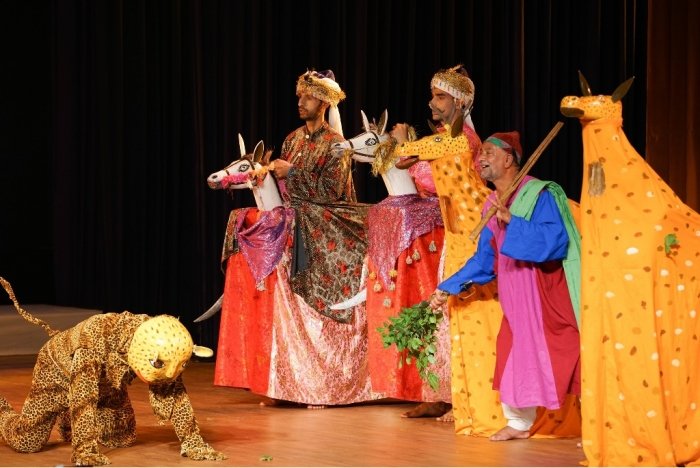 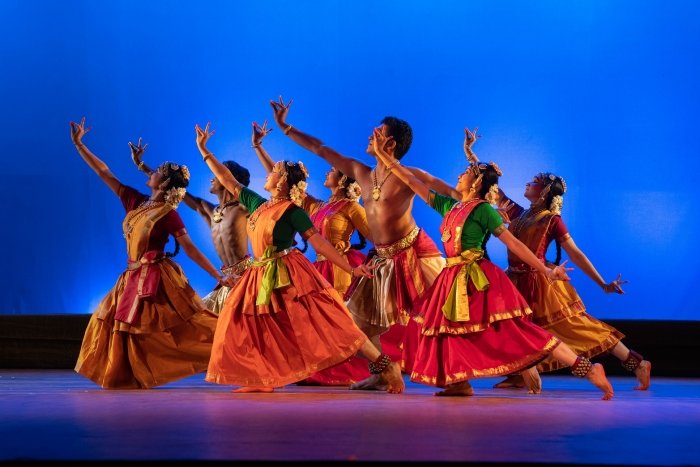 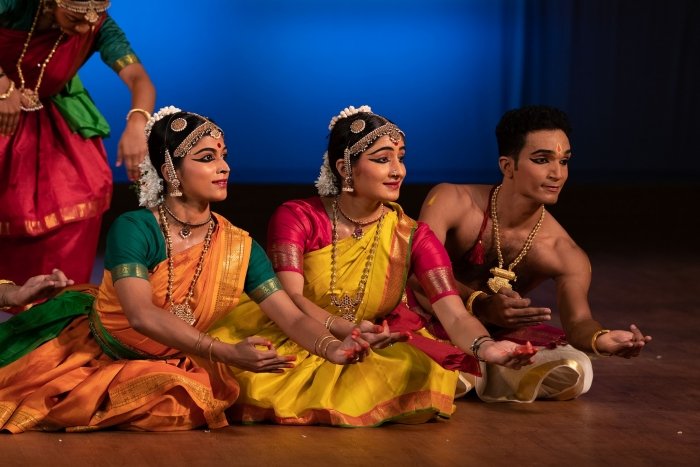 The signature video for the festival was on the Vitasta by Siddharth Kak. A delightful dance presentation on Sharada Stotram and Vitasta Sthuthi by the Kalakshetra troupe choreographed by Jyotsna, Shali Vijayan and Haripadman, with music composed by Hariprasad, had all the professional finesse of Kalakshetra. The National School of Drama presented dance and live music on Kashmir and Vitasta. Kashmiri folk dances were a delight. Kashmiri folk music and Sufi music by Aabha Haanjura and troupe was another fine event. The Therukoothu presentation organised by V.R. Devika (which one missed) was evidently a great success. Spread on the grounds was a Kashmir crafts bazar which attracted a lot of attention. Vitasta festival, in the elaborate way it was conceived (and being presented in other parts of India) is an eye opener for most Indians, on why one treasures Kashmir as a treasured, inalienable part of India.  Writing on the dance scene for the last forty years, Leela Venkataraman's incisive comments on performances of all dance forms, participation in dance discussions both in India and abroad, and as a regular contributor to Hindu Friday Review, journals like Sruti and Nartanam, makes her voice respected for its balanced critiquing. She is the author of several books like Indian Classical dance: Tradition in Transition, Classical Dance in India and Indian Classical dance: The Renaissance and Beyond. RESPONSE * Just finished reading your most erudite piece and marvelled at the tenacity and engagement with which you covered the festival. - Dr.Utpal K Banerjee Post your comments Pl provide your name and email id along with your comment. All appropriate comments posted with name and email id in the blog will also be featured in the site. |